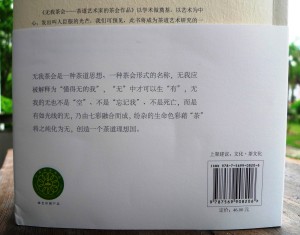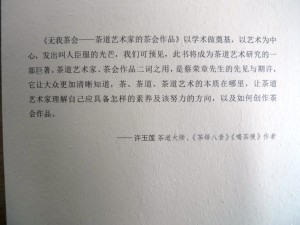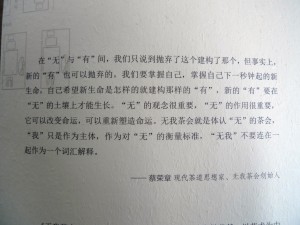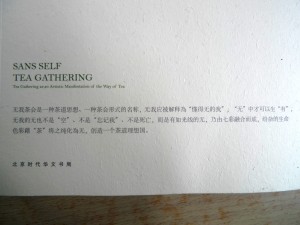马来西亚茶道研究会会长许玉莲于2017-01-29在浙江温州忘忧茶庄讲授“无我茶会”课
许玉莲亦是中国《茶道》杂志专栏作者、中国漳州科技学院茶文化系副教授兼茶文化研究中心研究员,农林大学人文茶文化学院客座教授许玉莲,著有:《茶鐸八音-茶文化復兴之声》、《我就要让这世界香》、《喝茶慢》、《茶道艺术家茶汤作品欣赏会》等书。2017-01-29上午,浙江温州忘忧茶庄召集了22位学员,在忘忧茶庄举行无我茶会课,举办茶会的实习。
(1221)

书 名:《无我茶会-茶道艺术家的茶会作品》
作 者:蔡荣章
出版社:北京时代华文书局
ISBN:9787569908206
版次:1
包装:平装
开本:16开
出版时间:2016-05-01
用纸:胶版纸
页数:280
*封面介绍:
一代宗师蔡荣章 茶道思想经典作
自1980年当代茶文化複兴,第一个建立系统的茶会-无我茶会
茶会模式自1990年实施27年。跨越10多个地区(台湾、中国、韩国、日本、马来西亚、新加坡、美国、英国、意大利、法国等)
10000多场次,500000多人次参与,188条茶会操作细节
共同专注于茶道技术与艺术的生命力
目录:
蔡荣章自序:无我茶会——茶道艺术家的茶会作品
第一章无我茶会的基本形式与做法
001.无我茶会的基本形式
002.无我茶会特殊做法及七大精神
003.无我茶会为何非要单边奉茶不可
第二章场地问题
004.室内以什么场地为宜
005.室外以什么场地为宜
006.一定要在幽静与风景优美的地方举办吗
007.下雨怎么办
008.举办夜晚无我茶会时,场地需要多亮的公共照明
009.地形特殊,无法达成连续性队形,怎么办
010.在舞台从事示范性表演时的座位排法
011.作为纪念性无我茶会时,场地如何应变
012.席地而坐时,一个人的空间需要多少,两人相隔的距离该多少,座位前面应保留多少活动空间
013.这个场地能容纳多少人
014.茶会在野外举行,卫生问题如何克服
第三章场地的准备
015.场地规划图
016.座位的标示
017.号码牌的排列方向
018.「向心坐」与「背心坐」
019.场地有外人走动时,怎么办
020.与围观群众的区隔方法
021.号码牌的制作
022.座位标示图的应用
023.茶会名称的标示
024.音响的设置
025.解说员与表演者的位置
026.纪念性无我茶会
027.座位的控制
第四章报到时段
028.抽签、签名等报到手续
029.人多时,如何缩短抽签与签名的时间
030.报到人数的掌握
031.人数与座位的控制
032.想让没带茶具的朋友也一起参加茶会,怎么办
033.以无我茶会作为欢迎茶会时怎么做
034.带着幼儿一起参加,应否设置「母子签」,坐折迭椅区者如何抽签
035.「对时」如何实施
036.要设「引导人员」吗
037.茶会进行间要不要有专人负责临时发生的事情
038.缺席的座位号码牌如何处理
039.工作人员何时入场
040.迟到的人怎么办
041.表演者、解说员等的座位安排
042.因无可奈何的原因使得茶会无法依原定时间进行,如何补救
043.无我茶会是大家一起参与的茶会
第五章与会者会前的准备
044.无我茶会茶具「精简」的要求
045.无我茶会的基本道具
046.无我茶会的「茶具」应注意哪些使用上的功能
047.如何携带茶具才好
048.保护茶具的包装器材有何应留意的地方
049.带什么「茶」才好
050.「茶」如何携带
051.泡两种茶叶时,茶具如何准备
052.泡茶用水的准备及对保温瓶的要求
053.无我茶会就座的方式
054.坐垫的功能要求
055.会前下过雨,或担心坐在有泥的地方,应增加什么配备
056.无我茶会的服装与鞋子
057.茶会间安排有茶食享用时,如何准备
058.无我茶会泡茶法举例之一:小壶茶
059.无我茶会泡茶法举例之二:盖碗茶
060.无我茶会泡茶法举例之三:抹茶
061.上述泡茶法举例,为何都没有提到温壶、烫杯等动作
062.无我茶会对「夜晚茶会灯」的要求
063.参加无我茶会应达成多少目的
064.如何轻松愉快地享受无我茶会
065.逍遥于茶会的广场
066.无我茶会的茶具就是「旅行用茶具」
第六章就位与联谊时段
067.每人的坐垫应如何放置才会整齐
068.就座后号码牌如何处置
069.杯子正放还是倒扣的好
070.向围观者奉茶时,对外奉茶的杯子要陈列出来吗
071.安排有「供应茶食」时,带来的茶食要不要摆放出来
072.夜晚无我茶会时,茶会灯放哪儿比较好
073.户外风大时怎么办
074.茶会前下过雨,场地潮湿怎么办
075.户外昆虫的问题
076.「茶具观摩与联谊」何时开始、何时结束、有何替代方桉
077.茶具观摩的礼节
078.如何发挥联谊的效果
079.如何对围观群众发放「简介」
第七章无我茶会的泡茶与奉茶
080.无我茶会使用「简便泡茶法」
081.何时开始泡茶、何时开始奉茶
082.第一道如何奉茶,杯子放在哪里
083.奉茶时,杯子由谁拿取,无法蹲下的人如何奉茶,走动不便的人如何奉茶,盲友的茶会如何应变
084.第二道以后如何奉茶
085.奉茶时要不要说「请喝茶」,被奉者要不要说「谢谢」
086.奉茶一定要依前后的次序吗
087.奉茶时从座位的哪一边出去
088.奉茶时遇「空位」及「不泡茶者」,怎么办
089.若许多位「品茗后活动」的表演人员未能一起泡茶,如何让他们有茶喝
090.若设有解说员,如何奉茶给他
091.如何奉茶给围观的人
092.泡茶杯数与泡茶次数如何决定
093.泡两种茶时,如何操作
094.泡茶用水不足时,如何补充
095.茶会间若安排有茶食享用,如何进行
096.茶会没安排供应茶食,可因自己泡抹茶而提供茶食吗
097.纪念性无我茶会等特种场合的奉茶法
098.对围观者的询问及要求,如何因应
099.奉茶间的礼节
100.什么时候开始喝茶,从哪一杯开始喝
101.喝茶时应快快地喝还是慢慢地喝
102.茶叶浸泡期间,做什么才好
103.泡茶进度超前或落后时,有何调节的方法
104.如何避免摄录像破坏气氛
105.无好恶之心的真谛
第八章品茗后活动与收拾
106.何谓「品茗后活动」,如何进行,与「会后活动」有何不同
107.品茗后活动如何与演出者协商
108.品茗后活动要不要设置表演台
109.泡完茶,要不要当场清理茶具
110.如何预防收拾茶具后,壶盅的残水外流
111.收拾茶具前之擦杯动作,意义何在
112.何时开始擦拭自己用过的杯子
113.收杯礼节
114.茶具如何收拾
115.泡茶结束后还剩有茶汤怎么办
116.个人泡茶位子的复原
117.茶会如何结束
118.公共设施的收拾
119.茶会后全体合影
120.有些「人」或「事」需要特别感谢或说明时,怎么办
121.无我茶会表现的茶道艺术
第九章茶会进行间
122.奉茶方法发生了错误怎么办
123.别人奉给您的茶少了一杯,怎么办
124.所泡的茶倒不完怎么办
125.遇到自己喝不下的茶怎么办
126.不爱喝茶,或今天不能喝茶,但又喜欢参加茶会,怎么办
127.奉茶时,发现自己的前一杯茶尚未被喝掉,怎么办
128.收杯时,遇到剩有茶汤怎么办
129.茶没泡好,可以做些补救措施吗
130.泡茶时发现水量或泡出的汤量明显不足,有何应变方法
131.可以倒一杯给反方向的芳邻吗
132.杯子的卫生问题
133.不知道喝的是什么茶,可以问吗,可以赞美他吗
134.最后一道茶奉完,可以走到景仰的人那儿要杯茶喝吗
135.会后可以与别人交换茶具作纪念吗
136.茶会结束后可以再约些人原地继续泡茶吗
137.无我茶会可以使用非茶的饮料吗
138.无我茶会错误最多的地方
139.无我茶会的「自由」与「法制」
第十章主办单位的会前准备
140.举办无我茶会的时机
141.如何拟定无我茶会的名称
142.勘察场地
143.有哪些工作需要专人负责
144.谁是无我茶会的工作人员
145.「公告事项」的制作
146.「会前说明会」的举办
147.「工作检查表」的应用
148.茶会记录
149.如何掌握参加的人数
150.无我茶会的各项进度需要多少时间
151.参加无我茶会的人,应如何识别
152.无我茶会要义图
第十一章茶会的推广
153.无我茶会推广工作如何进行
154.将无我茶会列入茶道教育课程
155.四学分的无我茶会课程安排
156.无我茶会又为茶道加了藩篱吗
157.无我茶会道场的设置
158.无我茶会茶具完整性的重要
159.无我茶会的机动性与扩充性
160.如何使无我茶会的风格与特性突显出来
161.无我茶会是随意还是严谨
162.无我茶会为什么不设贵宾席与长官致词的时间
163.无我茶会进行间为什么不放音乐
164.「品茗后活动」演出人员最好也是参加无我茶会的人
165.推广性无我茶会的举办
166.无我茶会在其他场合的应用
167.无我茶会的英、日、韩译
168.什么是无我茶会的国际组织
169.无我茶会需要统一的会旗与会歌吗
170.无我茶会的传播
171.无我茶会的字面意义是什么
172.无我茶会不只是一种茶会形式
173.一人到千万人的无我茶会
174.无我茶会的四美
175.无我茶会是要求精致的一种茶道体系
176.无我茶会对个人与群体的影响
第十二章无我茶会简史
177.无我茶会的创办
178.无我茶会的出生背景
179.为什么有无我茶会的诞生
180.从独饮到无我茶会
181.第一次无我茶会的举办
182.第一次公开举办的无我茶会
183.第一次国际无我茶会
184.无我茶会专书的出版
185.第一座无我茶会纪念碑在武夷山
186.从「无我茶会推广委员会」到「国际无我茶会推广协会」
187.无我茶会大事年表(1989~2015)
第十三章对外解说稿
188.无我茶会解说稿
许玉莲跋1:无我茶会的理想国
许玉莲跋2:论蔡荣章的《无我茶会——茶道艺术家的茶会作品》



 (1462)
(1462)
給臺灣無我茶會茶友的一封公開信
—兼論折疊桌椅的錯誤使用
蔡荣章
參加過第15屆國際無我茶會在浙江大學與千島湖舉辦的前二場無我茶會,發現嚴重的錯誤。為什麼五大圈的隊伍中央還有折疊式桌椅圍成的一個小圈圈?他們不依抽籤的號碼就坐,是被邀或自行坐在那裡的,又沒依公告事項的進度,自行泡茶,一面聊天,不依單邊方向奉茶,還在會中接受採訪。
是培訓不足嗎?但浙江大學那場只有一位中國茶友,其餘都是臺灣的資深無我茶會會員,千島湖的那一場,則全都是。
有人說,那是主辦方為無法跪坐、無法蹲下來奉茶的人而設,但我看到許多人不是那樣的。看在其他茶友與圍觀者的眼裡,還以為中央小圈圈是特權人士才可以進去坐的,但無我茶會沒有給予這種特權。若属主辦方為行動不便者著想,這些桌椅要並列排進大圈圈的隊伍裡,號碼簽留給需要的人抽取。這些茶友可以不必跪坐泡茶、蹲下奉茶,如果約定往左邊奉茶,左邊最後三位坐在桌椅者會奉茶到無桌子的席位,這時可以請被奉者自己端一下茶或把空杯子放到奉茶盤上,若被奉者亦出去奉茶,等一下就會回來的。這樣才能照顧到不便的人也不破壞無我茶會的規則。這種安排必須寫在公告事項裡,讓需要的與會者知道。
坐在第七第八部大巴的茶友說他們回去後就要教無我茶會,有人說要取得無我茶會指導老師的證書才好,有人說要到發起地臺灣考證才正宗。臺灣無我茶會的茶友不要做錯誤的示範,上課時還要有錯誤舉例的一節,努力把無我茶會的面貌與精神呈現。
(1655)
第十五屆國際無我茶會,2015年10月24日~10月28日浙江舉辦
大会会程说明:
1. 无我茶会:10月25日、26日、27日将举办三场无我茶会,各团体会员请自备无我茶会茶具。
2. 领队会议:10月24日20:00主办单位将报告筹备情形,并讨论有关事宜,请各团体推派1至3名(含翻译)代表参加,并讨论下届主办国(地区)。
3 惜别晚宴:10月28日晚宴,请各团队准备一个表演节目,十分钟左右,以相互联谊、同乐。
4. 茶艺茶道表演:10月25日下午将在浙江大学举办一场茶艺茶道表演,由主办单位邀请各团体参与演出。10月26日、27日、28日晚上是否进行茶艺茶道表演,到时再根据需要而定。
主办单位:浙江省茶叶学会、中国国际茶文化研究会、杭州市茶文化研究会、淳安县人民政府、龙泉市人民政府、浙江大学茶学系和西湖区茶文化研究会等联合主办
会议时间:2015年10月24日~10月28日
会议地点:浙江·杭州
会议日程(*具体行程到时可能会小调整)
第一天(10月24日周六)
全天 报到(杭州萧山机场—紫金港国际酒店)
20:00—22:00 代表团团长会议,确定下一届举办单位
第二天(10月25日周日)
8:30—10:00 境外茶友参观浙江大学校园和茶学系
10:00—12:00 浙江大学千人无我茶会(紫金港校园)
12:00—13:00 校内食堂午餐
13:00—17:30 各代表团茶艺茶道邀请演出
18:00—21:00 欢迎晚宴(浙江大学万人食堂三楼)
晚上自由活动或继续各代表团茶艺茶道演出。
第三天(10月26日周一)
7:30—10:00 杭州——千岛湖
10:00—12:00 千岛湖景区秀水无我茶会(第二场无我茶会)
12:00—13:30 酒店自助餐
13:30—17:00 游览千岛湖景区及茶园茶厂(分批进行)
18:00—20:00 酒店自助餐
20:00 “水之灵”大型文艺演出
第四天(10月27日周二)
7:00—10:00 千岛湖——龙泉
10:00—12:00 龙泉无我茶会(第三场无我茶会)
12:00—13:30 龙泉国际大酒店自助餐
13:30—15:30 参观青瓷博物馆和茶厂
15:30—17:30 游览龙泉青瓷宝剑园区
18:00—19:30 龙泉百菇宴
20:00—21:30 “牵手”大型文艺演出
第五天(10月28日周三)
7:00—13:00 龙泉——杭州龙坞
13:00—16:30 龙坞茶村农家午宴及茶馆茶园考察
16:30—18:00 龙坞——杭州住宿酒店
18:30—21:00 惜别晚宴
(1544)
無我茶會的「自由」與「法制」
Balancing ‘Freedom’ vs ‘Confinement’ at the Sans Self Tea Gathering
蔡荣章 Rong-tsang Tsai
At a Sans Self Tea Gathering, seating is decided by random drawing. Participants settled down in a loop formation, then brew and serve tea in one direction for a pre-agreed number of brews. They remain seated after enjoying the last round of tea for a few minutes of music appreciation or meditation, before collecting their cups and packing up. The gathering then comes to an end. All participants of Sans Self Tea Gathering need to bring along their choice of tea ware and tealeaves; as such, there is no restriction on the method of brewing or the types of tealeaves used. This realizes one of the seven principles of Sans Self Tea Gathering: that there is no restriction as to the style or regional practice.
As the tea gathering progresses, small teapots, lidded cups and matcha tea bowls make their appearance; indeed, this is an interesting showcase of varieties. Sans Self Tea Gathering is a great opportunity to experience the different styles and regional practices of brewing in one occasion, where tea has brought people together. Differences only add to the substance and enjoyment of the Way of Tea. Everyone is free to make their choices and not confined to using a particular kind of tealeaves and brewing method.
Having said that, the absence of confinement is not a warrant for being ‘sloppy’ or ‘not serious’; otherwise, the standard of the tea gathering will go down. Participants will have to give it their all, and present the best possible tea infusion with their chosen brewing methods and styles. The ‘method’ is not confined, but it cannot be said for the ‘quality’.
The absence of confinement also refers to the discouragement of rigid ‘rules’ and ‘brewing rituals’. While rules are crucial for the existence of Sans Self Tea Gathering, and brewing rituals are the basis upon which one’s spirit in the Way of Tea is founded, mechanical and formalistic practices will easily turn the event into a stage performance.
It is certainly not our aspiration to have Sans Self Tea Gathering becoming a mere style of tea gathering, or a school of thought pertaining to the Way of Tea. The rules and spirit must be maintained, and the quality keeps improving. Freedom and confinement, for this matter, will complement and balance each other.
(1536)
無我茶會的「自由」與「法制」
Balancing ‘Freedom’ vs ‘Confinement’ at the Sans Self Tea Gathering
蔡荣章 Rong-tsang Tsai
無我茶會是以抽籤決定座次,大家圍成圈圈泡茶,泡完茶,依同一方向奉茶。泡完約定的次數,聽一段音樂或靜坐幾分鐘,收回杯子,收拾茶具,結束茶會。茶具與茶葉都是自備,帶怎樣的茶具,使用怎樣的泡茶方式,沖泡什麼茶葉,都沒有約束。所以無我茶會在七大精神中有一款是:無流派與地域之分。
茶會進行時,經常看到小壺茶、蓋碗茶、抹茶等不同的茶具同時出現,泡茶的方式與風格也各異其趣。由此讓人很容易地體會到與會者是出自不同的門派、來自不同的地區。大家沖泡的都是茶,品飲的也都是茶,不同的泡法與茶味只是增益了大家茶道生活的內涵與樂趣,作為結合各流派、各地域茶人共同泡茶、品茶的無我茶會當然是「茶葉、泡法不拘」了。
但是我們不能將此項「不拘」解釋為「隨意」與「不嚴謹」,否則茶會的品質就低落了。在你選定的泡茶方式與風格之下,應儘量表現得圓滿且具境界,茶湯更是不能泡壞了,不拘的是「方式」,而不是「品質」。
上述的「不拘」尚有一層意義,那就是不拘泥於一定的「茶會規則」與「泡茶儀軌」。茶會規則是無我茶會存在的必須條件,泡茶儀軌是個人茶道精神賴以維護的基礎,但是太過機械化、太過形式化,很容易變成了一部表演機器。
我們不希望無我茶會變成僵化的一種茶會形式或茶道流派,它的規矩與精神必須維護,品質必須不斷提升,就有如「自由」與「法制」的相互約制與相互成就一般。
(1805)
無我茶會錯誤最多的地方
The Question on Sans Self Tea Gathering with the most wrong Answer
蔡荣章 Rong-tsang Tsai
One of the questions for the 10th screening test for instructors of Sans Self Tea Gathering has an exceptionally high rate of error, at 66%. The question is as follows:
Which of the following should not be specified in the Notification?
A) the method to make tea B) the way to take tea C) the way to be seated on the seating mat D) the tea ware to be used
Prior to a Sans Self Tea Gathering, the Organizer would distribute a ‘Notification’ , which specifies the name of the tea gathering, time, venue, the way tea is to be served, the event flow and the distribution of task. ‘The way tea is to be served’ refers to the number of teas to be brewed, the number of brewing for each tea, the number of cups for each brewing, the direction in which tea is to be served and to which participant (e.g. first, third and fifth, etc), and whether onlookers will be served; if so, in what ways. This enables participants to understand the way in which a certain Sans Self Tea Gathering will take place.
As a rule, the Notification should not name the types of tea for brewing. The exception will be a ‘Green Tea for spring’ Sans Self Tea Gathering, whereby participants are requested to make green tea. But it should not specify the origin or brand of the green tea. On the same basis, a Sans Self Tea Gathering should not be organized in the name of a certain tea plantation or brand name.
No restriction should be imposed on brewing. Any method, style or school of brewing is acceptable. As such, tea ware is not to be standardized. The requirement is for participants to brew well and the tea to be safe for consumption. Beverages that are not ‘genuine tea’ are not allowed. Since there is no restriction on the way to make tea, there is also none on ‘the way to take tea’.
You may wonder, if the way of brewing, serving and drinking is not restricted, isn’t there nothing much to be standardized? The fact is, when an instructor conducts training on Sans Self Tea Gathering, students are asked to follow instruction. It is because the instructor has identified, in his opinion, the best way for participation in a Sans Self Tea Gathering. However, if you have found a way that better suits you when it comes to attending a Sans Self Tea Gathering, you may go for it. This is not a matter of right or wrong.
The answer to this question is: All items (A, B, C and D) should not be specified in the Notification.
(1511)
無我茶會錯誤最多的地方
The Question on Sans Self Tea Gathering with the most wrong Answers
蔡荣章 Rong-tsang Tsai
第十屆國際無我茶會指導老師甄試時,學科考試的第二十條答錯率高達66%。該題內容為:下列哪些項目是不可於公告事項上約定的:
(A)泡茶的方法 (B)喝茶的方法 (C)坐上「坐墊」的方法 (D)使用的茶具
無我茶會舉辦之前會對與會者發放“公告事項”,上面寫明茶會名稱、時間、地點、奉茶的方式、茶會的程序,以及工作分配等等。所謂“奉茶的方式”是指這次茶會要泡幾種茶、每種茶泡幾道、每道茶要奉幾杯、要向什麼方向奉給第幾位茶友、要不要奉茶給圍觀的人及如何的奉法。有了這些約定,參加無我茶會的人就知道應該如何進行這場茶會了。
但是在公告事項上不可以約束大家泡哪類茶,除非這次的茶會定名為“綠茶迎春無我茶會”,則可以要求大家都泡綠茶,但不可以進一步限制一定要沖泡哪個產區的茶、或是哪個廠牌的茶。依此類推,無我茶會也就不能以某某茶葉產區或廠牌為名來召開了。
無我茶會也不可以限制泡茶的方法,任何的泡茶方式、任何的流派都被允許。因此,所使用的茶具當然也不可以加以規範。但是將茶泡好,而且安全衛生是被要求的。非“真茶”類的飲料也不在被允許的範圍。居然泡茶方法不拘,那“喝茶方式”當然也不能設限了。
泡茶、奉茶、喝茶的方法都不受限制,當然也就沒有非怎麼操作不可的規定,然而在無我茶會的教育訓練上都有一套制式的規則,老師講解時、要求同學練習時都是依章行事,為什麼呢?因為老師選定了這套他認為最好的方式來參與無我茶會,所以他要求向他學習的茶友要如此地執行。但是如果你有更適合自己的泡茶方式,在參加無我茶會時是可以使用自己的方式的,這個時候老師不可以説你不對。
所以這條試题的答案是ABCD皆不可於公告事項上約定。
(1584)
無我茶會表現的茶道藝術
The artistic manifestation of the Way of Tea as expressed by Sans Self Tea Gathering
蔡荣章 Rong-tsang Tsai
Student: ‘As far as the Way of Tea is concerned, what is the difference between Sans Self Tea Gathering and other ways of making tea?’
‘Sans Self Tea Gathering is a form of tea gathering. It differs from the ten brewing methods we talk about from time to time; those are ways in which we make tea. Besides Sans Self Tea Gathering, there are also tea gatherings in the form of tea presentation setting, banquet or free-flow. Meanwhile, as you all know, brewing methods may involve small teapots, big containers or extended steeping of tealeaves, to name a few.’
‘In the artistic manifestation of the Way of Tea, the method of brewing is an application. How about the different kinds of tea gathering? ’
‘They are both applications in the artistic manifestation of the Way of Tea. Tea gathering is the style, brewing method is the means.’
‘Is the format of tea gathering and tea presentation setting the same as the “environment for tea drinking”?’
‘These are different concepts. The artistic manifestation of the Way of Tea should not be too dependent on, or too mindful of, the environment for tea drinking; otherwise, we will forget that we are brewing tea. The format of tea gathering, however, has an immediate impact on the art itself – the way tea ware affects the tea infusion and the brewing method the enjoyment of tea. The format of tea gathering should not be viewed as an environment for tea drinking; but rather, a part of the artistic manifestation of the Way of Tea.
‘Where lies the beauty of Sans Self Tea Gathering, apart from its role in the artistic manifestation of the Way of Tea?’
‘Although there is no event director on site, a Sans Self Tea Gathering takes place like clockwork. Each participant brews tea, then rise to serve tea to fellow participants on their left or right. After taking the first brew, each prepares another brew and serve, until the agreed number of brewing has been attained. After staying at their places for a short music appreciation, the participants go forth to collect their cups and pack. That’s when the tea gathering comes to an end. Throughout the tea gathering, no one speaks or directs the event flow; everyone follows the pre-agreed procedure and method. Such is the collective rhythm of Sans Self Tea Gathering – when all the participants put their heart and soul into brewing, serving and enjoying tea, a kind of beauty unique to the Way of Tea prevails.’
‘Would it be possible to look upon the entire tea gathering, from tea setting through tea brewing and serving to taking the tea, as a piece of work?’
‘Experiencing, or rather enjoying, the art of the Way of Tea is certainly realized by the entire tea gathering. The only worry is over emphasizing the impact of the event at the expense of the tea infusion; and the worry is real. Because of this, we have proposed the concept of the ‘Quintessential Way of Tea’, which helps us re-focus on the tea infusion. Tea, after all, is at the core of the artistic manifestation of the Way of Tea. This way, it won’t be mistaken as the art of tea drinking environment, the art of tea brewing or the art of moral enlightenment. You may say: Well, ain’t I making tea just the same? True, but the pre-requisite is the realization that tea, the infusion, is at the heart of the Way of Tea.
(1534)
無我茶會表現的茶道藝術
The artistic manifestation of the Way of Tea as expressed by Sans Self Tea Gathering
蔡荣章 Rong-tsang Tsai
「無我茶會與泡茶法在茶道藝術的架構上有何不同?」學生問。
「無我茶會是〝茶會型式〞的一種,而我們常提的十大泡茶法是各種不同功能的〝泡茶方法〞。前者的茶會型式還有茶席式的茶會、宴會式的茶會、流觴式的茶會等,後者的泡茶方法就如小壺茶法、大桶茶法、含葉茶法等等。」
「就茶道藝術而言,泡茶方法是應用的方法,那茶會型式是什麼呢?」
「茶會型式與泡茶方法都是茶道藝術的應用媒介。茶會型式提供茶道藝術表現的一種方式,泡茶方式提供茶道藝術表現的一種手段。」
「〝茶會型式〞與茶席設置時所謂的〝品茗環境〞是一個概念嗎?」
「不是一個概念。我們說茶道藝術不能太依賴、太關注品茗環境,免得忘掉了自己在泡茶。但是茶會型式卻是直接影響茶道藝術本體,就有如茶具直接影響茶湯一般、就有如泡茶方法直接影響茶湯的被享用一般,茶會型式不能視為品茗環境,茶會型式與它要表現的茶道藝術是綁在一體的。」
「拋掉無我茶會在茶道藝術架構上的地位,無我茶會有何茶道藝術上的美感境界?」
「無我茶會在無人指揮的情況之下,大家將茶泡好,起身將茶依同一方向奉給左鄰或右鄰的茶友,然後大家喝茶,喝完茶又開始泡茶,泡完茶大家又一起起身奉茶。喝完最後一道茶,靜坐原位聽一段音樂,然後大家出去收回自己的杯子,收拾茶具,結束茶會。在大家席間不語、無人指揮的情況之下,大家依照事先約定的程序與方法進行著茶會的種種過程,這是茶道進行的一種美感。大家都不說話地專心泡茶、專心奉茶、專心喝茶,也是茶道的一種美感境界。」
「能不能從茶席設置到泡茶、奉茶、品茗,將整個茶會視為一件作品來看呢?」
「體會,或說是享用茶道藝術當是以茶會全場為標的,只怕大家太關注整場的演出效果而忽略了茶,事實上是極易導致這樣結果的,所以我們提出純茶道的理念,要大家把重心放在茶上,放在茶道藝術的核心上,只要這麼做了,自然就是茶道藝術,而不是品茗環境藝術、不是泡茶藝術、不是道德藝術。大家會說:我不是在泡茶嗎?沒錯,但這個前提必須充分把握住茶道的核心:茶,茶湯。」
(1603)
無好惡之心的真諦
The true meaning of ‘setting aside personal preferences’
蔡荣章 Rong-tsang Tsai
‘Setting aside personal preferences’ is important when it comes to appraising tealeaves – our preference for certain types of tea makes it hard for us to be objective and unbiased when we are assessing the quality of teas. The same can be said of Sans Self Tea Gathering. A participant may be served with four types of tea (if each person is served four cups) because there is no restriction on tealeaves. As such, we have to accept and appreciate the tea offered by others. Keep our mind and heart open, and ‘set aside personal preferences’.
Having said that, ‘setting aside personal preferences’ is different from ‘not being able to tell the good from the bad’. There are two sides to the idea – firstly, it refers to the absence of a very strong feeling towards what one likes and dislikes; secondly, it refers to the ability to rise above personal feelings when we look at, accept and even appreciate matters that are different from what we are accustomed to. In the world of tea, there are different varieties – green tea, pu’er, oolong, black tea, and a lot more. If you insist on drinking oolong and neglect green tea, you are depriving yourself of the beauty of green tea. Meanwhile, tealeaves come in different qualities, from unbelievably good to downright poor. Your may choose to take only tea of premium quality, but what if there is none? You will probably say, “Well, this is not my cup of tea.” Or think, “I would rather pass on it than corrupting my taste”. Some fellow tea drinkers declare, “I take only the first two brews (referring to small pot brewing)” just to tell the others that latter infusions are not good enough for them. This attitude has left much to be desired because it rules out possibilities. By putting themselves on a materialist high ground, they are imposing upon themselves a form of self-imprisonment – it is not uncommon to see some people bolstered by wealth, knowledge or moral authority staying in self-built prisons and act in stereotyped ways.
This will bring us to what Laozi said: Harmonize with all that is bright as daylight, and identify with all that is common as dust. By breaking down the barrier between the self and the world around – light and dust included – we will be able to feel genuinely free in this vast universe.
What we advocate is an open mind and an open heart. Appreciate different types of tea with objectivity. Accept tea of different grades. Take all infusions, first or latter, with pleasure. The study of tea may be about progress –better quality tealeaves, better brew and better tea-drinking environment. And yet, we should not rule out latter infusions of lesser quality tea (as allowed by circumstances) if these are made with one’s best effort. (1659)
無好惡之心的真諦
The true meaning of ‘setting aside personal preferences’
蔡荣章 Rong-tsang Tsai
我們評鑒茶的時候會提到「無好惡之心」,因為對不同茶類的喜愛度有了差異,在評判茶葉品質高下時就不容易做到公平與客觀。我們在無我茶會時,也會討論到無好惡之心,因為參加茶會時的茶葉是自行攜帶,如果每人奉茶四杯,每人可能會喝到四杯不一樣的茶,這時要以超然的心情來接納、欣賞這四杯茶,培養自己「無好惡之心」。
「無好惡之心」與「好壞不分」、「善惡不分」是不一樣的。我們所說的無好惡之心包含兩個層面的意義,一個是對不同事物或個體不要有太強烈的喜歡與不喜歡之心,另一個層面是要以超然的心情來觀看、接納、甚至於欣賞這些不同意義、不同境界的事物。就以茶為例,茶有綠茶、普洱茶、烏龍茶、紅茶諸種類,如果你一直固執於喝烏龍茶而不喝綠茶,那綠茶之美就一直無法進入你的領域。再就品質高下而言,各種茶都有好壞之分,如果你僅固執於喝好茶,那遇到沒好茶時怎麼辦?你可以說「不喝」、「寧缺勿濫」。又常聽到有些茶友說:「我只喝前面二泡。」(當然是指小壺茶而言),表示後面幾泡的品質已不足以令他欣賞。這樣的品茗態度、這樣的處世態度並不是我們贊同的,因為這只有將自己縮小在一個小區塊內,這小區塊是不是就叫做「養尊處優」呢?還不只此,那是一處讓遊客觀光的監獄。有些有錢人家、有學問人家、有道德的人家都是居住在這樣的別墅內的。
談到這裡,不禁讓人想起「和光同塵」的問題了,老子要我們與光綫、塵土為伍,要我們逍遥於大地宇宙之間。
我們主張:各種不同類別的茶都要客觀地欣賞、各種不同等級的茶葉都要接受、後面數泡的茶湯也要以愉悅的心情接納。我們精進於茶學,希望製造出好的茶葉、泡出好的茶湯、釀造出好的品茗環境,但不排斥在精心營造之下,無可避免之次級品、沖泡數道之後的老舊茶湯。(不在精心營造之下的劣质品可以不接受。)
(1783)
逍遙於茶會的廣場
Feeling Free and Easy at the Tea Gathering
蔡荣章 Rong-tsang Tsai
Sans Self Tea Gathering advocates simplicity. Participants bring along their favourite travel tea ware, sit on the floor in a loop formation, brew tea, offer tea to fellow participants on the left (or right) while reserving a cup for own consumption. Details are stated in the ‘Notification’ distributed before the event; these include the starting time, the number of cups and brews, ‘after- tea activities’ (e.g. music appreciation or a few minutes of meditation). After brewing, serving and taking tea, participants collect their cups, tidy up and the tea gathering comes to an end.
There is no restriction as to the choice of tea ware, brewing method and tealeaves. Brewing well is the only requirement; it is the means to express the Way of Tea as one sees it. As such, how could we feel free and easy at the tea gathering with such a format?
Here are some tips. Take the seat decided by random drawing without any attachment to outcomes. Brew well, and offer your tea to fellow participants on your left or right, be they someone you want to get acquainted with or not. You will feel relaxed when you offer tea if you know the format of the tea gathering by heart. Don’t be judgemental; a benevolent mind is preferred. Otherwise, you would wonder why you have to offer tea to people whom you don’t know or like.
Better still; imagine yourself taking a helicopter view of the Sans Self Tea Gathering in progress. You will see a large group of people brewing, serving and taking tea in an orderly manner without an event director. Participants on both ends may not even see each other; but this would not stop them from moving in collective rhythm. It is as natural as the way our universe works – just like putting on extra clothing in winter only to take it off when warmer climes return in spring.
In the myth of Peng (giant bird) and Kun (giant fish), Zhuangzi said we should open up our mind. Explore the world high up and deep down, the way Peng and Kun did. He also pointed out that ‘the perfect man cares for no self; the holy man cares for no merit; the sage cares for no name.’ This mindset will make us feel free and easy at the Sans Self Tea Gathering and beyond.
(1409)
無我茶會是大家一起參與的茶會
San Self Tea Gathering requires full participation of all
蔡荣章-Rong-tsang Tsai
There is a certain format to follow when we organize a San Self Tea Gathering. With simple tea ware for travelling, each participant is to be seated in a loop formation and serve tea in one direction for a pre-agreed number of brews, after which they will pack up. A key feature is participation of all – each participant will have to be fully involved throughout the tea gathering. This is why someone once concluded that a San Self Tea Gathering is an occasion when everyone brew, serve and enjoy tea.
When a fellow tea drinker wanted to organize a San Self Tea Gathering some time ago, he announced, “It is proposed that the occasion accommodates forty participants, among whom twenty will bring along their tea ware for brewing. The rest, who either have difficulty in bring their tea ware, or are not familiar with the procedure of a San Self Tea Gathering, will be treated as onlookers and served by their fellow participants.” We were dumbfounded upon hearing this, as it could not be further from the spirit of a San Self Tea Gathering. Firstly, such arrangement would have undermined the intention to do away with hierarchy – there are bound to be people who find it too troublesome to bring their own tea ware, and ‘privileged’ ones who think that they are to be served rather than to serve. As such, the Organizer need to remind participants individually to ensure there are enough participants bringing the required tea ware. The truth is if such activities are to adopt the name of San Self Tea Gathering, it is necessary for them to adopt the practice as well.
We may chance upon some friends while on the way to a San Self Tea Gathering. It is fine to ask the friends to come along. These non-brewing participants could draw lots for seating, and may be served tea by fellow participants. The only thing is the participants to their left (if this is the direction in which tea is served) would be served one cup less (since these are non-brewing participants). Meanwhile, for venues with a lot of people passing by, there may be ‘onlookers’ who are interested in the tea gathering. The Organizer may arrange for a presenter to explain the nature of the activity to these onlookers, and prepare some disposable cups for serving a couple of brews to them. Do note that this is different in implication from telling participants beforehand that some of them are exempted from bringing along their tea ware.
The organizers must be able to master the nature of the activities they are putting together; this cannot be truer than when we are organizing tea gatherings with clear ideology. A failure in presenting San Self Tea Gathering with integrity would make it very hard for newcomers to feel for it.
(1785)